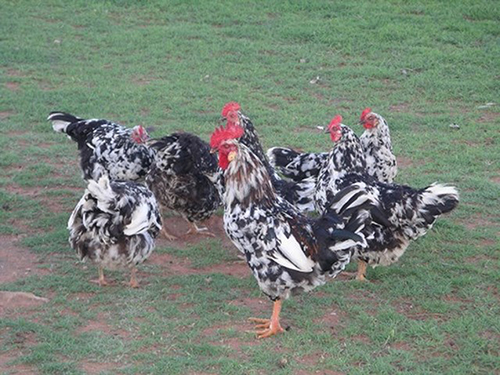Venda chickens were first described by a veterinarian, Dr Naas Coetzee, who noticed these distinctive chickens in the Venda area of what is now Limpopo and named them after the region. Although similar chickens were later identified in the Southern Cape and the Qwa-Qwa region of the Free State, the original name has been kept.
Indigenous poultry breeds are known for their hardiness and adaptability and Venda chickens are no exception.
The Venda is multi-coloured, although white, black and red or brown are the most noticeable colours. They have rose coloured combs. Sometimes they have five toed feet.
This breed is fairly large when compared with other indigenous breeds. The male mature weight can be 3.5kg and the female up to 3kg. They reach sexual maturity at 143 days.
The cock can be quite territorial and aggressive.
Hens lay large, pink tinted eggs. A normal production under free range conditions will be about 70 eggs a year. The hens are broody ~ this means that they sit on their eggs ~ and are very good mothers.
Adaptability
It is an ideal breed for a free-range environment. It has a relatively low need for food and its ability to forage and its resistance against diseases makes it very popular with subsistence farmers.

On the other hand it is surprisingly popular with show breeders.
This breed is well adapted to its environment. They are able to fly into trees to roost and to escape predators, they cope with a wide range of temperatures and are good scavengers.
Their diet is very diverse, as they will eat mealies and other seeds, household scraps, insects, lizards and even mice.
Some smallholders use these breeds for natural tick and fly control, where they pick ticks off grazing cattle.
They are also exported to neighbouring countries.
This is part of a series on common breeds in South Africa. For more, click here.


Pliz give me the link on how to contact you. 0729556189
Good day. You can email us on info@sasmallholder.co.za
I am looking for pure breed venda chickens. Pretoria
Hello
I need a image of a Venda Chicken for my new X account.
I would like to use the one in this article. Please confirm if I can do so.
Thank you